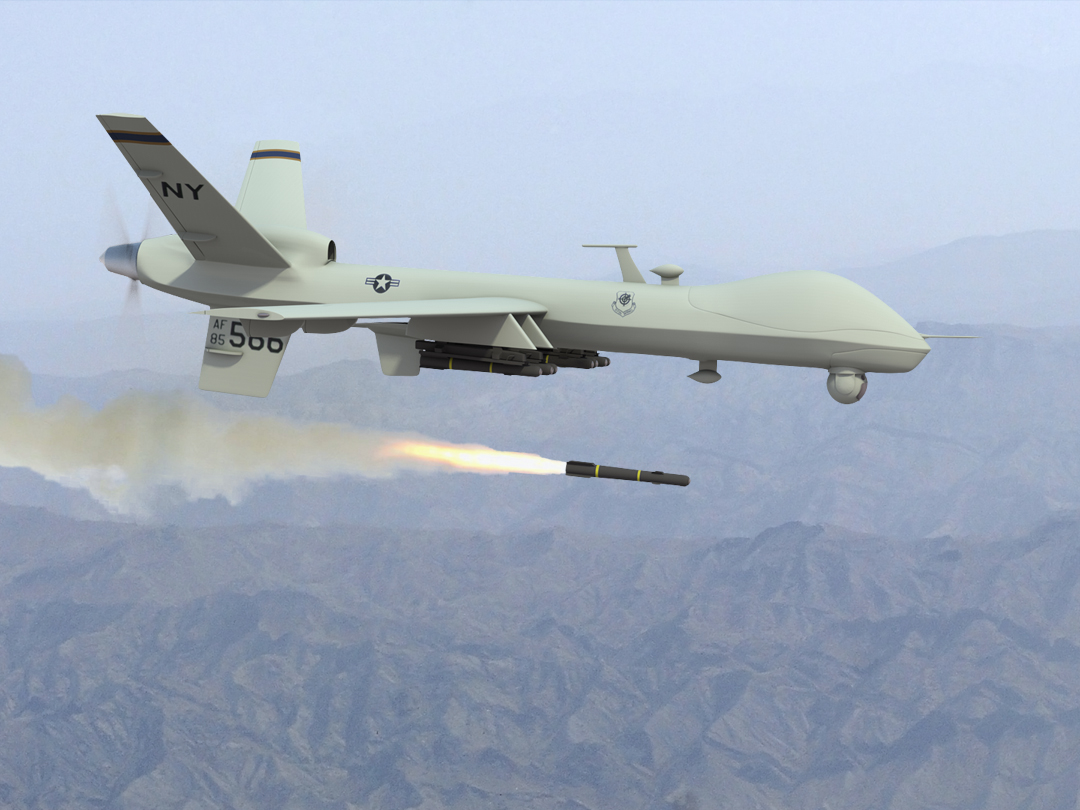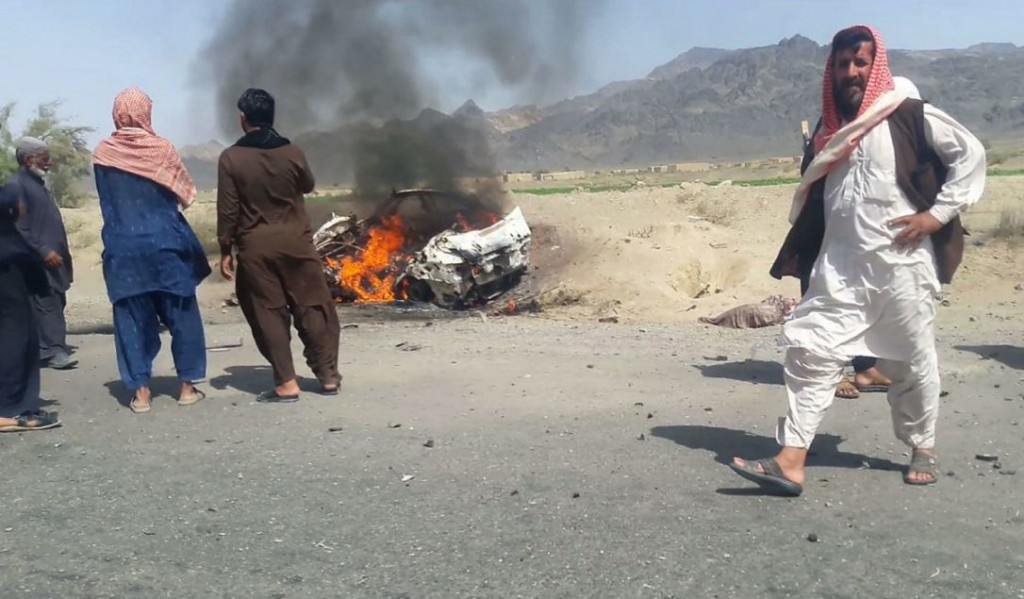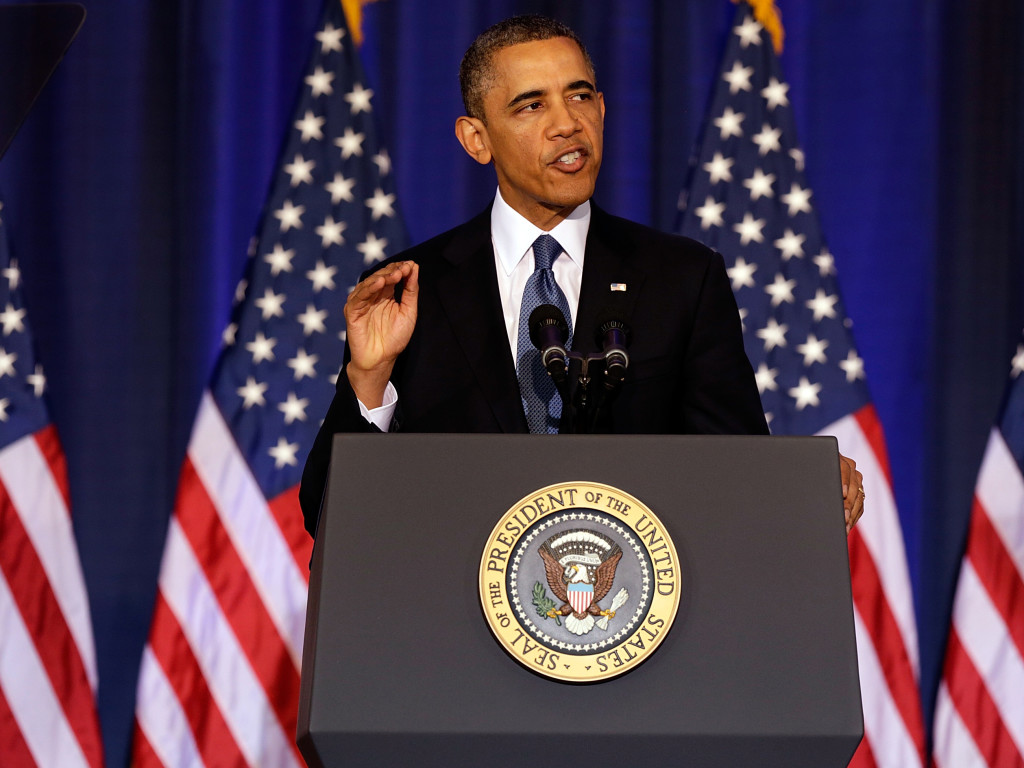Death From Above: A New Sphere of Empire in the Name of Self-Defense
 Reaper drone commonly used by CIA (along with Predator).
Reaper drone commonly used by CIA (along with Predator).
On May 21st 2016 at 6am, Mohammad Azam’s family lost one of its members and sole economic provider. Mohammad was killed in a drone strike while innocently performing his job as a taxi driver. His passenger, and the target of a CIA executed drone strike, was Afghan Taliban leader Mullah Monsour. Mohammad’s disabled brother is attempting to bring legal action against the United States for leaving four children fatherless and a family of six without an income. The drone strike took place in Pakistan and without the foreknowledge of the government, breaching Pakistan national sovereignty.
Barack Obama has embraced his executive privilege to approve target killings of suspected terrorists. He drastically increased the number of targeted killings by armed, un-manned drones in sovereign nations outside areas of active battlefields. According to International Security Data Site, more than 500 drone strikes have been authorized and implemented during Obama’s presidency in Pakistan, Somalia, and Yemen. The Bureau of Investigative Journalism has kept scrupulous records of U.S. drone strikes, their targets and casualties. They report that since 2004 only 84 (or 4%) of an estimated 2,400 people killed by CIA drone strikes in Pakistan have been named members of al-Qaeda.

According to international law and the international treaties agreed to by the United States, the use of armed drones strikes by Obama’s administration and the CIA are illegal.1 The United States defends its drone policy against Pakistan as “non-international armed conflict,” which is, in fact, not a lawful use of force. In the Report of the Special Rapporteur on extrajudicial, summary or arbitrary execution, Philip Alston states that:
“[a] targeted killing conducted by one State in the territory of a second State does not violate the second State’s sovereignty if either (a) the second State consents or (b) the first, targeting State has a right under international law to use force in self-defence under Article 51 of the UN Charter.”
Al-Qaeda and its affiliated groups do not constitute an organized armed group engaged in intense fighting as outlined in the Geneva Conventions. Neither is the use of drones legal in the sense of eliminating an imminent and continuous threat. Those killed by U.S. drones are killed so pre-emptively, and under the assertion that leaders of these terrorist organizations are actively planning future attacks on United States citizens or property. This does not constitute a proportionate and necessary response to an imminent threat.2 How exactly did the United States find itself in such an illegal and unjust assault on the Middle East?
***
The world changed forever following the terrorist attacks of September 11th, 2001. What truly sealed the fate of the Middle East was the Authorization for Use of Military Force Against Terrorists (AUMF). Section 2 of the Authorization gave the President broad power to wage war against any persons or any nation remotely involved in the attacks of 9/11:
“(a) IN GENERAL- That the President is authorized to use all necessary and appropriate force against those nations, organizations, or persons he determines planned, authorized, committed, or aided the terrorist attacks that occurred on September 11, 2001, or harbored such organizations or persons, in order to prevent any future acts of international terrorism against the United States by such nations, organizations or persons.”

The Afghanistan War ensued, as the Taliban failed to respond to the United States’ non-negotiable demands to turn over al-Qaeda members within Afghanistan, particularly their infamous leader, Osama bin Laden. The legality of the attack on al-Qaeda was justified under Article 2(4) of the United Nations Charter which provides that a state is permitted the use of force in collective self-defense against an armed attack. The Taliban, seen as harboring and aiding al-Qaeda, became the premier target of the U.S. military.
The legality of the 2003 invasion of Iraq was even more tenuous than that of Afghanistan. Failure of Saddam Hussein’s regime to comply with Resolution 1441 of the United Nation’s Security Council (UNSC) was used as grounds to begin a military campaign against Iraq. The resolution was unanimously agreed upon within the council because concerns of military conflict were assuaged by the US and UK Ambassadors to the United Nations, who stated that the “serious consequences” upon Iraq’s failure to comply would not “automatically” trigger the use of force. The matter would “return to the Council for discussions as required in paragraph 12,” said John Negroponte. However, after the U.S. unilaterally invaded Iraq, President Bush defended his nation’s actions by stating that no Security Council agreement was needed because Iraq had breached the ceasefire agreements of the First Gulf War. UNSC Resolution 678 granted member states all necessary means to implement the unconditional withdrawal of Iraqi forces from Kuwait—legitimizing the First Gulf War. Thus, legal scholars of the US and UK administrations argued that the 2003 Iraq invasion was legal based on the Security Council’s acceptance of use of force in a conflict occurring over a decade prior.
All of these events were legitimized and defended to the American public in the name of self-defense, counterterrorism, and waging the “War on Terror.” Following a seven-year, $13,000,000 inquiry into the Iraq War, the Chilcot report was published on July 6th of this year. Sir John Chilcot stated that while a view on the legality of military action could only be expressed by an internationally recognized court, the investigators had “concluded that circumstances in which it was decided that there was a legal basis for UK military action were far from satisfactory.” As it became clear that Iraq had in fact complied with the UN Security Council by destroying its weapons of mass destruction and had few serious links to terrorism, justification for the war was fortified on the grounds of human rights violations perpetuated by the Hussein government.
Though President Bush initiated the U.S. use of armed drones, President Obama has increasingly relied upon them for counterterrorism in non-compliant countries—that refuse to turn over or prosecute suspected terrorist leaders.
***
While Obama has been commended for his de-escalation of the Afghanistan and Iraq wars, he has implemented a policy of perpetual war around the world with no definable boundaries. During his two terms, outrage concerning his drone policy has bubbled to the surface following certain public revelations.
In 2010 Anwar al-Awlaki, a United States citizen, was placed on a kill-list by Obama. A case to remove Anwar was brought against

Obama, the Director of the CIA, and the Secretary of Defense by the Center for Constitutional Rights and the American Civil Liberties Union upon request by Anwar’s father. A federal court dismissed the case due to lack of legal standing and the political question doctrine, which holds that the nature of the event in question is fundamentally political rather than legal. On September 30th, 2011, Anwar Awalaki was killed by a drone strike in Yemen. His son, Abdulrahman al-Awalaki, was likewise killed two weeks later by another drone strike, along with nine other people. U.S. officials stated he was accidentally targeted. The assassination of United States citizens in an area unaffected by military hostilities without due process and in violation of International Human Rights Law made waves back home. However, it did little but to highlight American exceptionalism—that the illegal killing of citizens of foreign nations was justified if it saved American lives, despite the right to life as outlined and defended by international law.
The Obama administration and the CIA have also received grave criticism for their use of signature strikes, mostly in Yemen. These strikes target people with suspicious patterns of behavior and kill them without identifying them as armed combatants. The release of these classified documents undermines Obama’s justification that the drone program only kills high-valued targets in cases where arrest or detention is impossible. Likewise many mid-to-low level foot soldiers have been killed in drone strikes, individuals that have only recently been affiliated with terrorist organizations and pose little threat to the security and safety of the United States.
The United States is in blatant violation of International Humanitarian Law and International Human Rights Law. Obama’s legal defense has been vague, and limited mainly to speeches. Without increased transparency by both the CIA and the current administration there is little hope that public opinion or the international community can successfully reform or deter this policy.
The White House recently released the death toll of civilians killed by airstrikes outside of war zones, totaling 64 to 116 individuals. However, this death toll is far lower than what human rights groups and NGOs have reported. President Obama also issued an executive order on July 1st to address pre- and post- strike measures to diminish civilian casualties. It includes the potential monetary recompense to those injured or to the families of those killed by drone strikes, something that Obama has failed to do in the past seven years, even for the families of Americans killed by drones. Likewise, an annual report of civilian deaths will be released, though only from 2016 onwards. These measures are important and depict a move towards structure and accountability but they are easily reversible by the subsequent president and do not pertain to the lack of accountability within Obama’s time in office.
The president’s administration claims that drone strikes are the most effective way to combat terrorism, and result in far fewer casualties than would conventional means. Al-Qaeda has lost many of its leaders and key members to drone strikes, but has also gained unequivocally through increased resentment towards the United States by the broader population and the resulting rise in recruitment, or “radicalization.” Many well-informed and involved experts such as 3-star General Mike Flynn, 4-star General Stanley McChrystal, and the CIA itself have warned of the counter-productive nature of this policy.
In a very real sense the United States’ UAV airstrike policy has become a form of terrorism in itself. Attacks in the Waziristan region of Pakistan have been particularly common and fatal. American drones hover over the region daily, and local inhabitants try to evade being targeted by altering their everyday activities. They avoid funerals, which have been targeted in the past, do not send their children to school and avoid community meetings of leaders, which likewise have been targeted. It has been recorded that following an attack, a second missile will be launched to kill first responders, who are most often local villagers seeking to provide medical attention and to help those in distress.3
Not only does treating al-Qaeda and its associated groups as armed combatants with which the U.S. is at war provide them with legitimacy, but the use of drones has also drastically altered public opinion towards America. The illegal intervention of the United States in the Middle East has fueled the campaign against the West, not disdain for “freedom” or “democracy.” The United States presents a disastrous example for future countries that gain military drone capabilities, as well as those nations that already have them.
What Obama’s policy comes down to is its legitimacy and legality, not its supposed efficacy. The United States has founded a new arena for empire, which effectively has no bounds or rules or accountability. The targeted, premeditated assassination of suspected terrorists or individuals of a particular behavioral pattern who are unarmed and not actively partaking in hostilities against the United States is justified by an argument of self-defense. With a few thousand suspected terrorists assassinated by drones outside of war zones alone, it is doubtful that the United States has come closer to holding those responsible for the September 11th attacks accountable for their criminal activities. Due process and justice is sacrificed for the economic, political, and military ease of a drone strike that takes place outside the scope of the American public. The heinous and criminal act committed by a dozen individuals has been framed as some so-called active military effort and war, thus wiping away any pretenses of a legal or proportionate response, and castigating millions of people in the Middle East. Furthermore, and perhaps more intuitively, it is hard to justify the reprisal killing of individuals who have joined terrorist and associated organizations since 9/11 as a responsible reaction in the name of 9/11 and the AUMF.
Works Cited:
Marjorie Cohn, ed., Drones and Targeted Killing: Legal, Moral, and Geopolitical Issues (USA: Olive Branch Press, 2015)
1 Jeanne Mirer, “US Policy of Targeted Killing With Drones: Illegal at Any Speed,” in Drones and Targeted Killing.
2 Ibid.
3 John Quigley, “Drones Strike Blowback,” in Drones and Targeted Killing.
